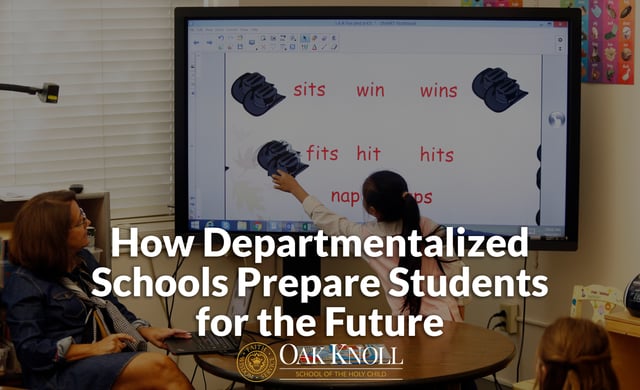Departmentalizing — or platooning — in schools means students change classrooms and share teachers who specialize in just a few areas. Sound familiar? It’s the way most middle and high schools have been structured for years. For elementary schools that have dropped the self-contained model to carefully embrace and implement this progressive concept for students as young as age 6, the benefits include increased classroom engagement, communication skills, student development and more. Here, we review six essential ways departmentalized education in elementary schools enhances learning for students and prepares them for the future:

Children in a departmentalized school experience teachers who are considered specialists in their curriculum. Because teachers in this environment are no longer generalists — or those who teach almost every subject — children learn from teachers who have a higher level of expertise in fewer areas. The teachers can truly offer specialized instruction to their students, enabling them to cater lessons based on the different types of learners in their class and enhance learning opportunities.
2. Increases engagement in the classroom
Gone are the days of students leaving supplies inside their desks because they stay in the same classroom all day long. Departmentalization breaks the monotony for elementary school students, who travel from class to class, just like middle and high school students. This slight interruption between classes allows students to release energy and refocus as they enter new classrooms. It also provides students with an opportunity to be challenged academically by different teachers in different classroom environments.
3. Advances communication skills
Students who travel inside a building or across campus to classes and classrooms end up developing a rapport with different teachers. This enables students to learn how to communicate with teachers who have different teaching styles and personalities. It enhances the student’s emotional and psychological development in an organic environment.
4. Optimizes learning time for all subjects
Teachers who are considered generalists have a lot of content to get through each day. But if there are disruptions or extra time is needed for students to fully understand a certain concept, other subjects may get skipped due to time constraints. In a departmentalized environment, each teacher focuses on one area, during a pre-set period or block, so students are guaranteed that all subject areas are taught and not just “fit in” when time allows.
5. Increases student support
In departmentalized education, teachers get to know every student in the grade. This means that teachers can take equal ownership over students – bonding with all students, not just the ones in their homerooms. Because teachers share all of the students in a given grade, they can take a cooperative teaching approach, which enables them to work together and coordinate lessons, communication with parents and students, and parent conferences.
6. Prepares students for the future
This progressive method of education prepares our youngest students for what lies ahead in middle and high school — even college. This method eases the transition to a middle school environment, often decreasing a student’s stress level as they may be headed to a new building or school altogether.
Want to learn more about departmentalization? Join us for a special open house on Wednesday, January 16, 2019, where we will be discussing Oak Knoll’s progressive model for students in grades 1-6. Register here.



